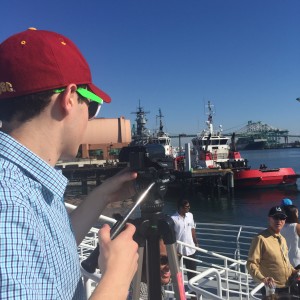It’s hard to look at the Port of L.A. and not think about Legoland on steroids — towers of interchangeable blue, grey, and orange containers climbing up toward the sky, cranes as tall as skyscrapers, and a handful of life-size people who, against this scale, looked like little more than Lego men, keeping the whole thing going.
My own forays with Legos were haphazard. Every project would become a multicolored wall about two blocks deep that an X-Men action figure or a plastic dinosaur would end up running through. A technicolored prop, basically. Of course, that bears absolutely no resemblance to the Port of L.A., whose container ships are the building blocks of international trade here in the United States.
Yes, I went there.
While the pun may be obvious, it applies in a number of ways. Sure, the port is the foremost container port in the U.S. (and, depending on whether you count neighboring Long Beach, either in the top 10 or top 20 worldwide). It’s also a living, ever-expanding testimony to the mechanics of modern trade, which is now the most streamlined and efficient it’s ever been. You’ll find thousands of containers packed neatly on ships and on the shores, you’ll ships of all sizes and purposes, you’ll even find sea lions. But absent from the shores of San Pedro are about 15,000 longshore workers.
Years ago, it would take that amount of man-power to offload these ships, which typically carry between 5,000 and 8,000 containers. Now, a few automated cranes can handle that load between two and five days, depending on the size of the ship. These efforts have been largely rewarded as the Port remains ever busy, thanks in part to a rebounding economy and new, expansive trade deals. One official noted that even a “bad year for cargo” typically sees growth of 4%.
Expedience is key in shipping, as the goods from these containers need to be transported throughout the United States, traversing America’s highways and railways before they land in your local Ralph’s, Target, Forever 21, Meineke, or Best Buy.
The number one good found in these containers now is furniture — and has been for the last twenty years. In second comes autoparts, which have seen an increase in import rates. These parts are shipped here from Asian, then assembled in autoplants throughout Mexico and North America (namely, Texas; Memphis, Tennesee and Detroit, Michigan). Next comes clothing and shoes, followed by electronic goods. Rounding out the U.S.’s top five imports are toys and sporting goods — the latter of which is already causing an uptick of activity at the port as the holidays approach.
And what are we sending back to Asia?
Air, for the most part. Since U.S. imports far outpace U.S. exports, many of our containers will go back to Asia empty. And what we do send back to countries like China aren’t ready-made goods, like the ones we receive, but commodities.
More specifically, trash.
The top export out of the Port of L.A. is waste paper — material you directly contribute to when you accidentally print out 10 copies of that out-dated resume. Next is metal scrap, which is shredded before being put on the ships, followed by plastic scraps, which will be recycled and repurposed in China before making their way back to the United States as eco-friendly dog bowls. Through the Port of L.A., we also send animal feeds and autoparts. Since the port also processes these materials, you don’t have to go too far to smell the burning metal, dust and rust of the scrap factory as it mixes in with the sea air.

Eli Goodstein, who refused to be intimidated even though his camera wasn’t the largest on the yacht.
In fact, along the shores of the Port is an entire ecosystem that features industries from the past and present. Nissans and Infinities fill one side of the dock, as 150,000 of these cars are brought in to the Port per year before being distributed throughout the U.S.
You’ll also find a cement processor — previously out of commission, but scheduled to rev up again in 2016 — and a borax factory. Not to be confused with the Kazakh reporter, borax is an earth mineral commonly used as a household cleaner that can only be found in South Africa, Turkey, and Southern California. Experts estimate that, as it stands, there are only 30-40 years of borax left on earth.
And that’s among the things most interesting about the port — how you can see remnants of old mechanisms, old industries, old ways of doing trade, even as management charges the port’s systems and technologies forward.


Leave a Reply
You must be logged in to post a comment.